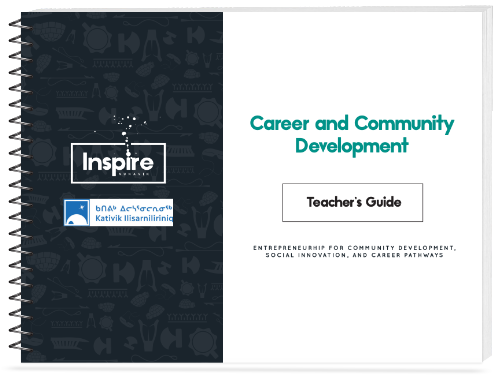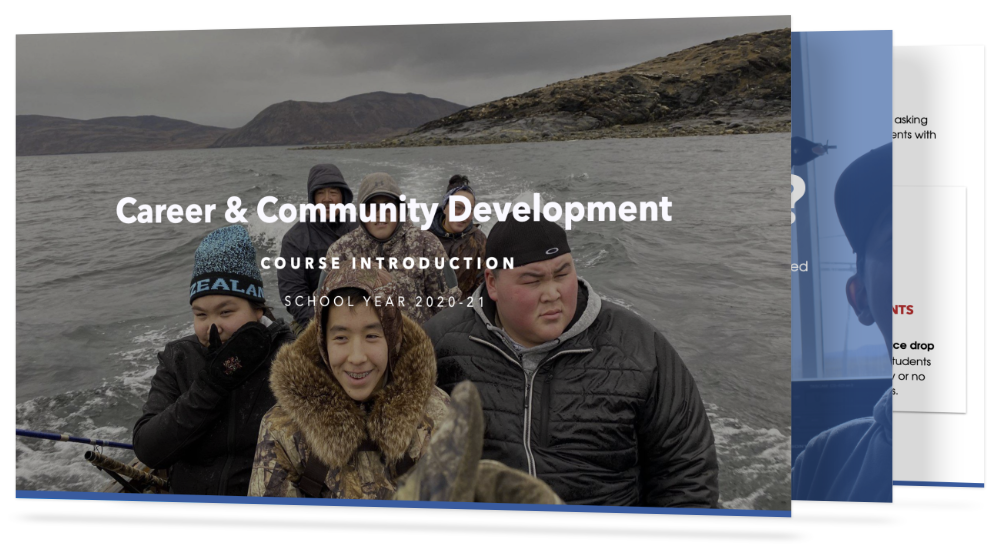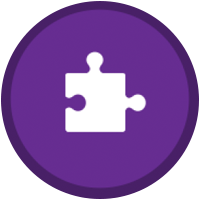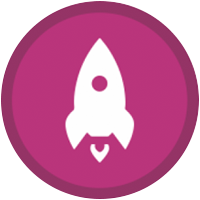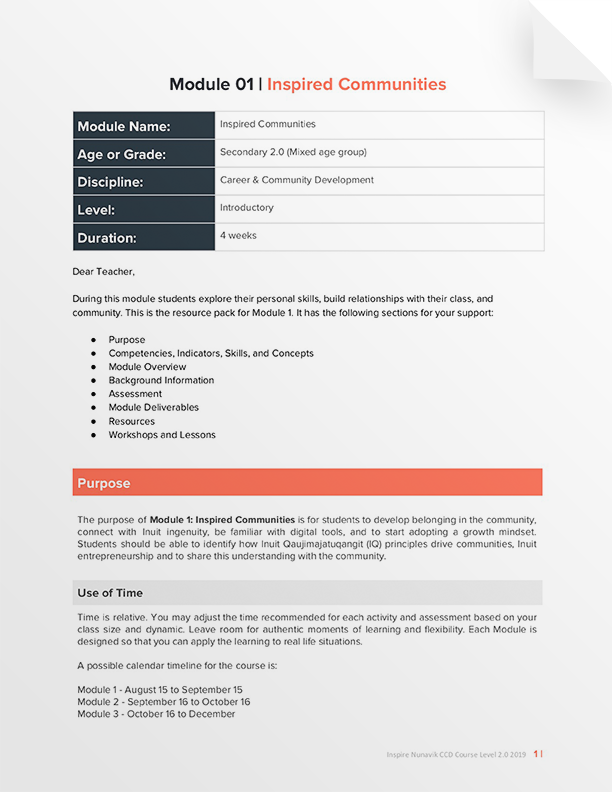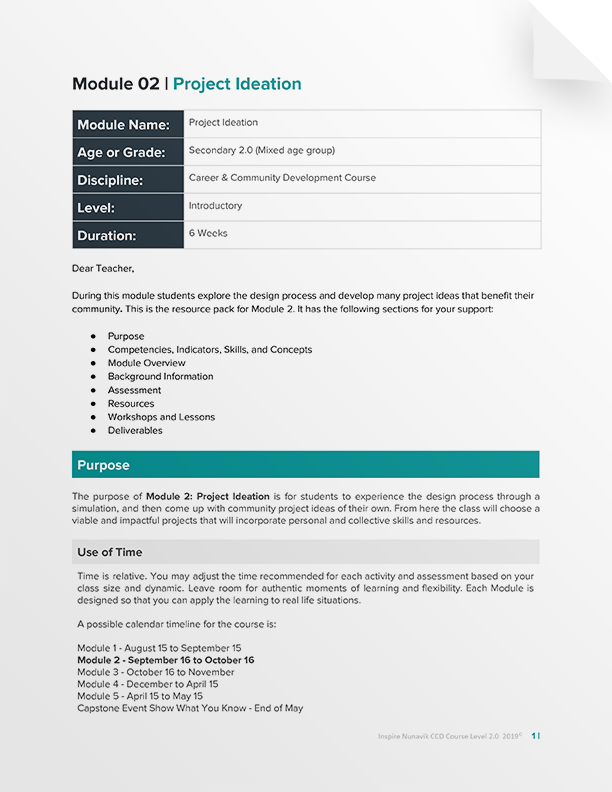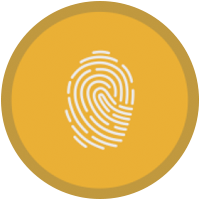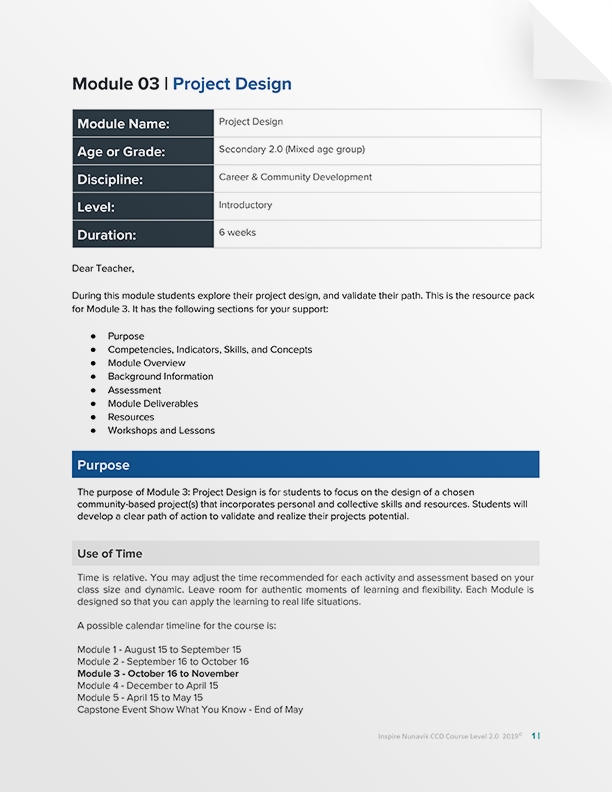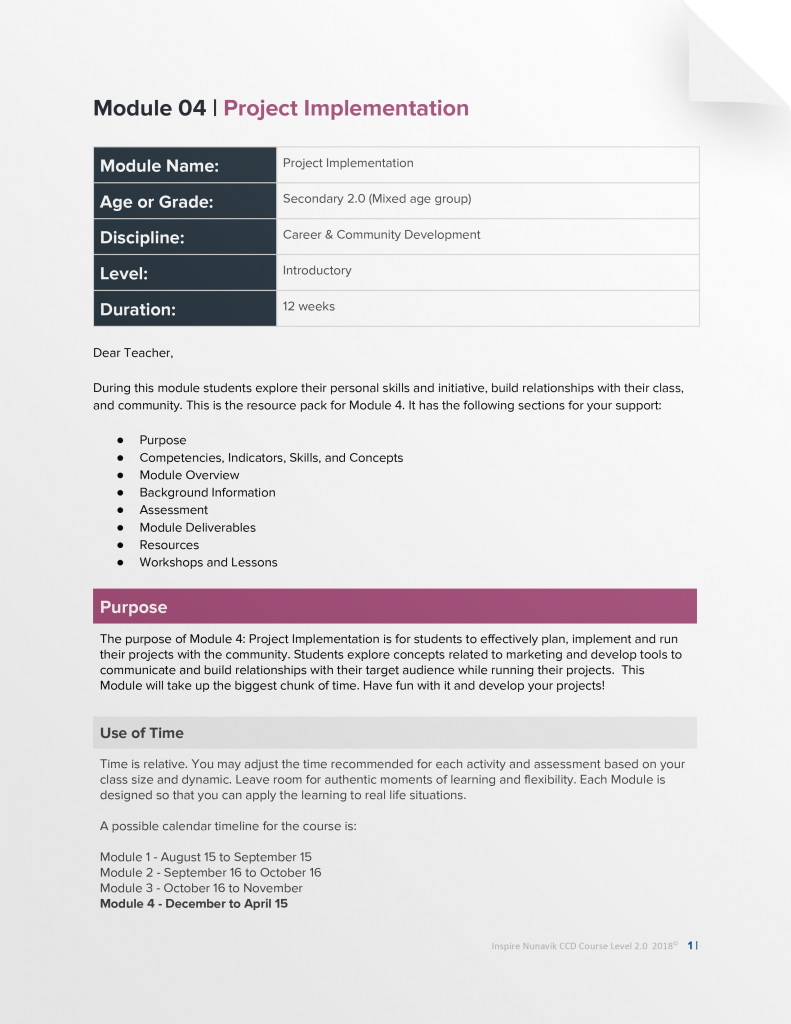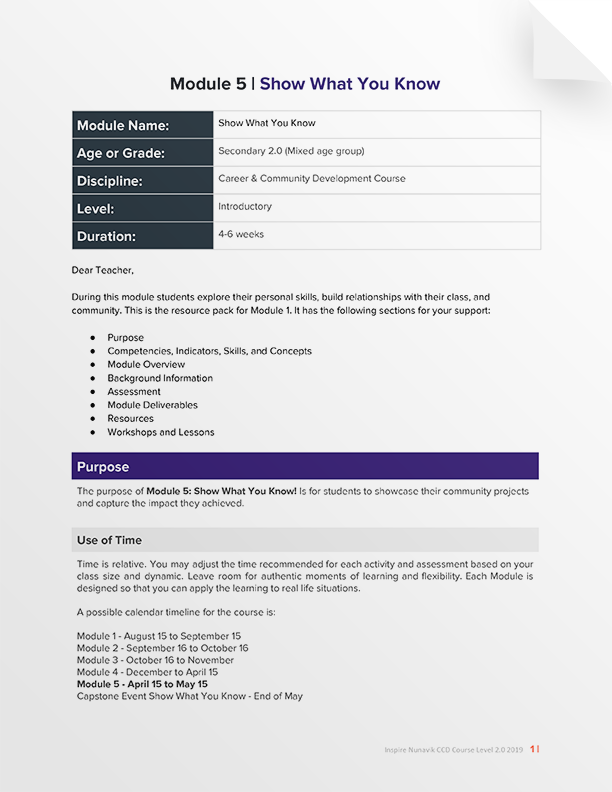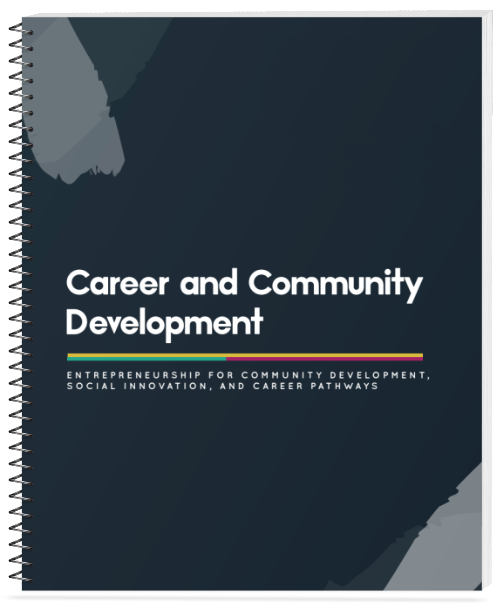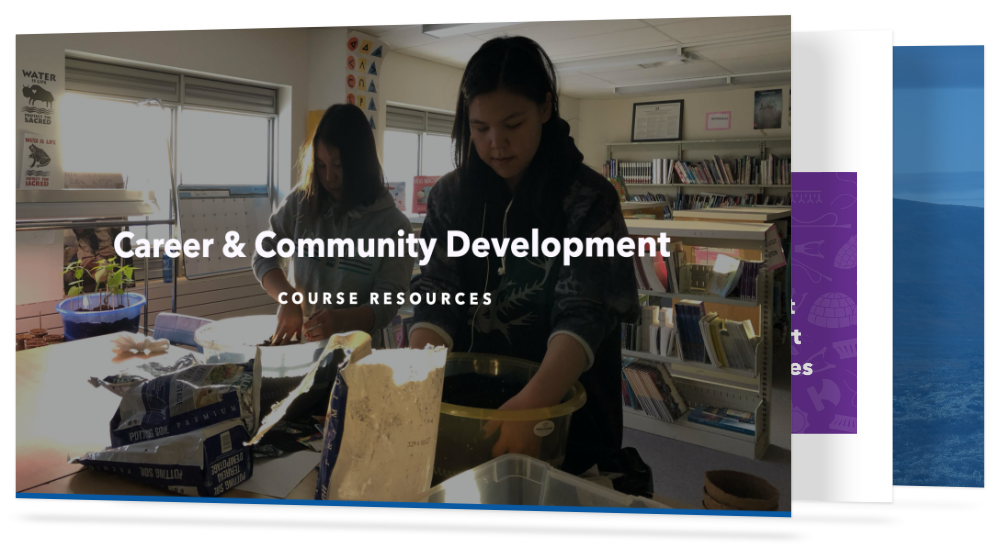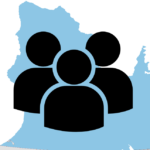Welcome to the Career and Community Development (CCD) course! CCD is designed to awaken the immense potential of young Nunavimmiut to harness their collective skills, values and interests to create thriving communities across the region. It does not follow a traditional model of education. Rather, it is a course that was specifically designed and developed to meet current and future needs of students in Nunavik. The purpose of this page is to provide tools and resources for the course.
1. Curriculum
1.2 Financial Education
As part of the compulsory curriculum from the ministry of education, students in secondary 2.3 are expected to receive Financial Education (FE). In most schools CCD is taught in a multi-level classroom which will require a mixed approach that uses both CCD and FE at the same time or the teacher can differentiate both programs simultaneously (which we do not recommend).
Below is a yearly plan that utilities both programs and demonstrates how we as a school are fulfilling the competencies of both programs. If your CCD class is a secondary 2.3 stand-alone class, you can simply replace the CCD materials with the FE materials for the full year.
For multi-level classes, it is recommended to utilize Chapters 1-5 of FE for Term 1, and 7-12 for Term 3.
2. Pedagogy
The CCD Curriculum is designed to strengthen communities by building critical life skills, building relationships, leveraging and creating community resources and strengthening culture through the creation of entrepreneurial projects.
Each piece of the framework will contribute to and be strengthened by student entrepreneurial projects, creating a looping system of positive outcomes for both students and communities.
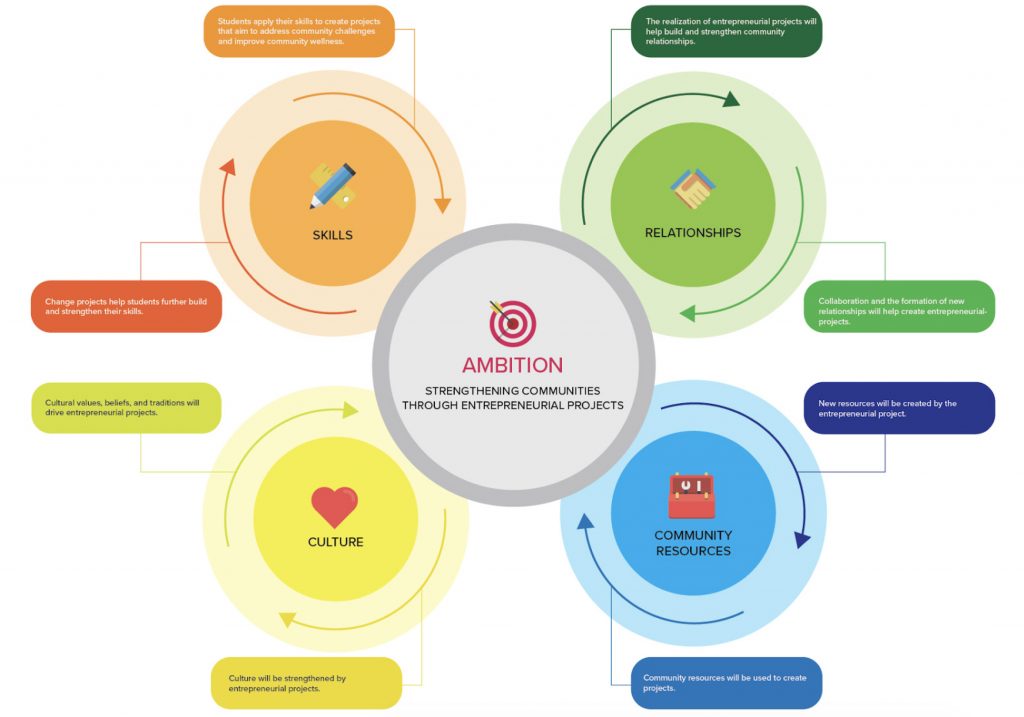
Ambition: Creating Entrepreneurial Projects
The ambition of the course is for students to develop a series of entrepreneurial projects that will contribute to their community’s wellbeing. Entrepreneurial projects are projects that harness the student’s learning, knowledge, skills and community resources to contribute to the community’s well-being in a real, tangible, and measurable way.
Community Resources
Entrepreneurial projects should be created from existing community resources. It is important for youth to recognize the value in the resources they have at their disposal, learn to mobilize them and
to create new resources from what they find. This is reflective of traditional Inuit lifestyle and a core entrepreneurial competency.
Skills
Students will develop and apply critical life skills such as innovation, entrepreneurship and creative thinking; citizenship; collaboration communication; critical thinking and inquiry; and self agency throughout the learning process.
Relationships
Community relationships and collaboration will be central to the success of entrepreneurial projects. Community members should be heavily involved in the course’s activities and students should engage with the community in meaningful ways throughout. This will foster and strengthen relationships between students, elders, community leaders, family and friends, entrepreneurs and other community members.
Culture
Culture will be the foundation for the course. The course must impart to students an understanding of how entrepreneurship connects
to their culture and how students can express and integrate their values and traditions into the course’s activities and experiences. Inuit culture is at the heart of the design, development and delivery of the entrepreneurial projects.
Presentation
Learn more about the pedagogy at the heart of CCD.
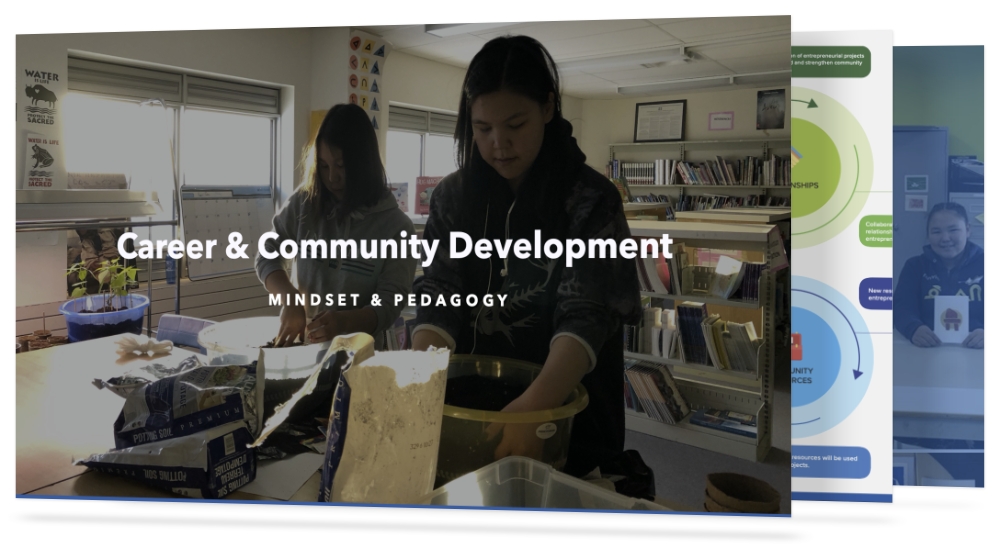
3. Project Examples
This presentation showcases examples of CCD students’ projects completed in 2019-2020.
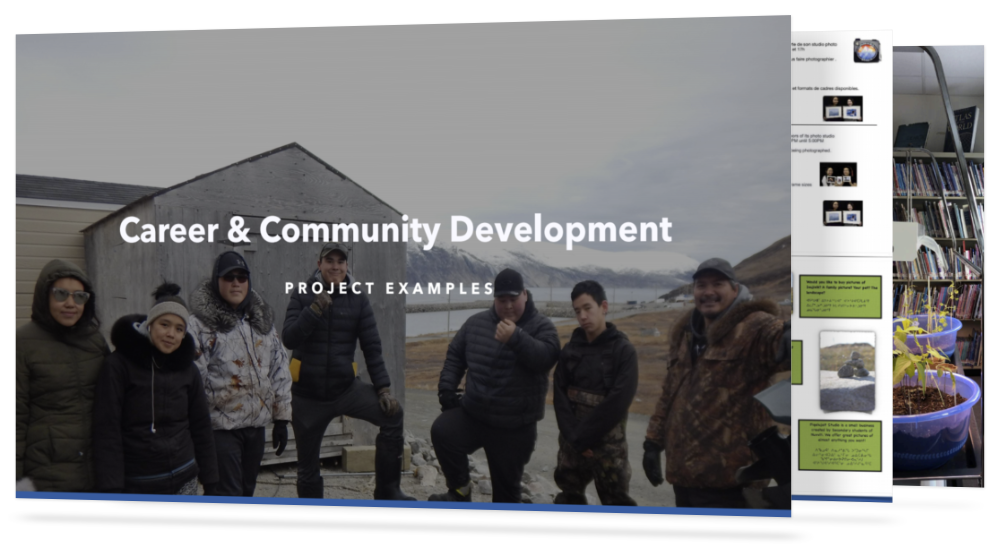
4. CCD Modules
The purpose of Module 1: Inspired Communities is for students to develop belonging in the community, connect with Inuit ingenuity, be familiar with digital tools, and to start adopting a growth mindset. Students should be able to identify how Inuit Qaujimajatuqangit (IQ) principles drive communities, Inuit entrepreneurship and to share this understanding with the community.
Module Overview
Students explore their personal skills, build relationships with their class, and community.
The introductory module, Inspired Communities, explores personal skill sets, classroom community, Inuit innovation, community culture in partnership with Elders and other members. The goal of Module 1 is for students to connect with community and understand the tools needed to be successful while engaging in a group project as related to Inuit ingenuity and the IQ principles. This will be achieved by (1) exploring both past and modern day innovations, livelihood, successes and challenges, and (2) developing a holistic outlook on community development by exploring community from a systems thinking lens.
Students will be prompted to derive many community questions about nature, economy, personal well-being, culture, and society. This will lead them to map personal and community resources, ideals, and challenges.
Innovation will be presented and explored as both a tool and a mindset of entrepreneurship that can be used to achieve community ideals and contribute to community betterment. Entrepreneurship traits will be connected to Inuit cultural traits and IQ principles. Specifically the module will explore relationships, growth mindset, digital worlds, and express their personal brand.
By the end of the module, students should be able to identify the personal and the community strengths and innovationsthey deeply care to pursue and leverage. This will set the stage for a learning experience grounded in the community, where subsequent modules are explored through the lens a project and theme of interest.
Competencies, Skills, and Concepts
Competencies
- Observes and understands Inuit Qaujimajatuqangit principles.
- Explores facts, knowledge, perspectives, and factors affecting a community.
Indicators
- Students will determine community ideals based on the collective good
- Students will identify their personal strengths in the classroom community
- Students will communicate what they understand about IQ using digital technology
- Students will develop a sense of belonging
- Students will develop empathy for and justifies multiple perspectives in the classroom community
- Students will reflect upon different identities: personal identity, cultural identity, community identity, & organizational identities
Critical Skills
Concepts
- Digital Technology
- Identity & Community
- Growth Mindset
Module Guide
The purpose of Module 2: Project Ideation is for students to experience the design process through a simulation, and then come up with community project ideas of their own. From here the class will choose a viable and impactful projects that will incorporate personal and collective skills and resources.
Module Overview
Students explore the design process and develop many project ideas that benefit their community.
In Module 2: Project Ideation, students will practice the design process in a workshop and then apply it to real life; developing project ideas that improves the community. Students will go through an ideation and design process in partnership with classmates and community members to come up with many project ideas that will be pitched for development.
Students will be called to identify different types of tools they can use to create their projects. The projects should harness the student’s unique skills and incorporate local resources. Using the Impact Gaps Canvas students can refine their ideas. After ideation, students will build prototypes of their projects.
Competencies, Skills, and Concepts
Competencies
- Ideate a community based project
Indicators
- Students will consider multiple perspectives, skills and resources to design a project
- Students will follow a human centred design process to create an idea for a project using collaboration, communication and empathy
- Students will present a prototype for a project using resources such as digital tools or multimedia
Critical Skills
Concepts
- Ideation
- Empathy
Module Guide
The purpose of Module 3: Project Design is for students to focus on the design of a chosen community-based project(s) that incorporates personal and collective skills and resources. Students will develop a clear path of action to validate and realize their projects potential.
Module Overview
Students focus on the design of a chosen community-based project(s) that incorporate personal and collective skills and resources. Students develop a clear path of action to validate and realize their projects potential.
In Module 3: Project Design, students will further design a chosen community-based project(s) by going through a simplified planning and development process.
Using their project model canvas as a tool, students will start by validating the project of choice. Validation means students will collect data from people affected by the project to inform the mission, direction and potential of their project ideas. The validation process should lead students to discover which pieces of their initial ideas work, which do not, and how they need to modify their initial idea to fit the needs of the community.
Once their project ideas have been properly validated, students will find the necessary resources to develop the project. Students will need to make a plan of action, brand identity, and fill out a funding application form. The learning in this unit will be specific to the needs of the community-based projects being developed.
Branding will touch on the question of identity. How do you want your audience to feel when they interact with your project? How will your project express itself? What colours, images, fonts, words best describe your project? What values do you stand for? The branding section should prompt students to reflect on identity – their personal identity, cultural identity, communal identity, and organizational identities – and what motivates and drives the project.
Competencies, Skills, and Concepts
Competencies
- Develops and validates a project concept
- Create an action plan to implement a project
Indicators
- Students will use various tools to determine the potential of a project and improve the design of a project
- Students will create a brand identity for a project
- Students will fundraise for a project
- Students will make and be a part of an action plan that lists key tasks, duties and timelines
Critical Skills
Concepts
- Validation
- Brand
- Project Planning
Module Guide
The purpose of Module 4: Project Implementation is for students to effectively plan, implement and run their projects with the community. Students explore concepts related to marketing and develop tools to communicate and build relationships with their target audience while running their projects. This Module will take up the biggest chunk of time. Have fun with it and develop your projects!
Module Overview
Students effectively implement and run their projects with the community. Students explore concepts related to marketing and sales and develop tools to communicate and build relationships with their target audience while running their projects.
In Module 4: Project Implementation, students will implement and run their community projects by utilizing their resources to achieve their goals. During this process, students will explore business concepts that help them better deliver their projects, build relationships with their audience, and grow the impact of their project.
Having a clear understanding of the project’s target audience will be central to the development of an effective implementation strategy. How will we reach our audience? How can we communicate the value of our community-based project to our audience? How can we grow our customer base? How can we use our creativity and skills to reach our audience in unique and effective ways?
By the end of Module 4, students should have applied marketing and sales techniques to effectively implement their community-based projects.
Competencies, Skills, and Concepts
Competencies
- Implements a project by utilizing resources
- Communicates and builds relationships with target audience using marketing and sales tools.
Indicators
- Students will use project planning resources acquired and/or created to run their project
- Students will describe customer segmentation, marketing channels and marketing techniques
- Students will identify the profile of a target market and audience
- Students will develop a communication strategy
Critical Skills
Concepts
- Marketing
Module Guide
The purpose of Module 5: Show What You Know! Is for students to showcase their community projects and capture the impact they achieved.
Module Overview
Students engage with the community to showcase their project and learning.
The final module, Module 5: Show What You Know, will be experiential, inviting students to engage with the community and showcase their projects. Show what you know is an opportunity for students to in a school board-wide and community focussed Capstone Event (details TBD), Each class will showcase their project & impact to fellow students across the region.
The outcome is for every student to participate in the execution of the project, the journey, learning, and impact to be communicated to a larger audience, and for students to provide reflections on this journey and identify how they grew from the beginning of the course
The final unit will give students the experience running an event that showcases a project in order to gain the confidence, affect real change, and develop their entrepreneurial mindset.
Competencies, Skills, and Concepts
Competencies
- Organizes and participates in an event that showcases community-based projects
Indicators
- Students will curate a community and school board-wide event as a part of a team
- Students will communicate and reflect upon personal growth and ability to make a difference in a community
- Students will evaluate the impact of a project
- Students will reflect on the value and meaning of IQ for Inuit entrepreneurial mindsets and community development
- Students will understand the importance of projects in developing community and personal skills for career options and portfolios
- Students will Identify next steps toward project development and long term vision of the project
Critical Skills
Concepts
- Event Planning and Community

